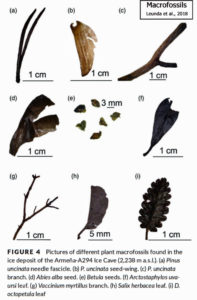by Fritz Vahrenholt, July 7, 2020 in NoTricksZone
First, the global mean temperature of satellite based measurements was surprisingly much higher in May 2020 than in April. In contrast, the global temperatures of the series of measurements on land and sea decreased. The difference can be explained by the fact that under warm El-Nino conditions the satellite measurements lag about 2-3 months behind the earth-based measurements.
From November 2019 to March 2020 a moderate El-Nino was observed, which has now been replaced by neutral conditions in the Pacific. Therefore, it is to be expected that also the satellite based measurements, which we use at this point, will show a decrease in temperatures within 2-3 months.
The average temperature increase since 1981 remained unchanged at 0.14 degrees Celsius per decade. The sunspot number of 0.2 corresponded to the expectations of the solar minimum.
The earth is greening
…
by Zhao et al., 2019 in BMCPlantBiology/CO2Science
Recognizing that increasing atmospheric CO2 concentrations promotes plant development and growth, Zhao et al. set out to investigate the effect of elevated CO2 on a key wine grape variety, Pinot Noir.
Their experiment was conducted in controlled climate chambers at the Fruit Tree Physiology and Biotechnology Laboratory, College of Horticulture, Gansu Agricultural University, China. Grape plantlets (Vitis vinifera, cv. Pinot Noir) were propagated and then cultured in a 2% sucrose solution at either ambient (380 ppm) or elevated (1,000 ppm) CO2 concentrations for a period of 25 days. At the end of the experiment the authors examined the impact of CO2 on various growth-related parameters, while also conducting transcriptomic and proteomic analyses.
Results indicated that elevated CO2 stimulated total plant dry weight, leaf area and plant height by 125%, 96% and 31%, respectively (see Figure 1). Photosynthetic parameters also revealed a CO2-induced stimulation and the various physiological changes were found to be related to differentially expressed genes and proteins among the plants growing in the two environments. Such findings suggest Pinot Noir may well be a “winner” (in terms of growth and development) among plants in the future if the air’s CO2 content continues to rise.

Figure 1. Visual display of the growth differences between grapes grown under ambient (380 ppm) or elevated (1,000 ppm) CO2 concentrations for 25 days. The average dry weight of the grapes growing under elevated CO2 was 125% greater than those growing under ambient CO2. Source: Zhao et al. (2019).
by From Nature Communications, June 18 in WUWT
Abstract
Most Earth system models agree that land will continue to store carbon due to the physiological effects of rising CO2 concentration and climatic changes favoring plant growth in temperature-limited regions. But they largely disagree on the amount of carbon uptake. The historical CO2 increase has resulted in enhanced photosynthetic carbon fixation (Gross Primary Production, GPP), as can be evidenced from atmospheric CO2 concentration and satellite leaf area index measurements. Here, we use leaf area sensitivity to ambient CO2 from the past 36 years of satellite measurements to obtain an Emergent Constraint (EC) estimate of GPP enhancement in the northern high latitudes at two-times the pre-industrial CO2 concentration (3.4 ± 0.2 Pg C yr−1). We derive three independent comparable estimates from CO2 measurements and atmospheric inversions. Our EC estimate is 60% larger than the conventionally used multi-model average (44% higher at the global scale). This suggests that most models largely underestimate photosynthetic carbon fixation and therefore likely overestimate future atmospheric CO2 abundance and ensuing climate change, though not proportionately.
by eLife, December 18, 2018 in ScienceDaily
Scientists have described a fossil plant species that suggests flowers bloomed in the Early Jurassic, more than 174 million years ago, according to new research in the open-access journal eLife.
Before now, angiosperms (flowering plants) were thought to have a history of no more than 130 million years. The discovery of the novel flower species, which the study authors named Nanjinganthus dendrostyla, throws widely accepted theories of plant evolution into question, by suggesting that they existed around 50 million years earlier. Nanjinganthus also has a variety of ‘unexpected’ characteristics according to almost all of these theories.
…
by K. Richard, November 26, 2018 in NoTricksZone
Newly published macrofossil discoveries from 4 papers strongly suggest that modern warmth may still be about 3°C colder than nearly all of the last 10,000 years.

….
by University of Birmingham, March 2, 2018, in WUWT
As the Earth’s surface and atmosphere warm, the amount of moisture – water vapour – in the atmosphere will increase. Understanding the size of this increase is important for predicting future climates as water vapour is a significant greenhouse gas. Atmospheric moisture content also influences the patterns and intensity of rainfall events.
The relationship between temperature and moisture content can be explored by the study of intervals in Earth’s history when climates where significantly warmer than those seen in modern times, which necessitates a method for estimating ancient atmospheric moisture content.
by Bristol University, February 19, 2019 in ScienceDaily
A new study on the timescale of plant evolution has concluded that the first plants to colonize the Earth originated around 500 million years ago — 100 million years earlier than previously thought.
For the first four billion years of Earth’s history, our planet’s continents would have been devoid of all life except microbes.
by University of California, September 12, 2017 in WUWT
A trend toward greater discrimination under higher CO2 levels is broadly consistent with tree ring studies over the past century, with field and chamber experiments, and with geological records of C3 plants at times of altered atmospheric CO2, but increasing discrimination has not previously been included in studies of long-term atmospheric 13C/12C measurements. We further show that the inferred discrimination increase of 0.014 ± 0.007‰ ppm−1 is largely explained by photorespiratory and mesophyll effects.
La géologie, une science plus que passionnante … et diverse


